
A flying arch is a form of arch bridge that does not carry any vertical load, but is provided solely to supply outward horizontal forces, to resist an inwards compression. They are used across cuttings, to avoid them collapsing inwards.

A flying arch is a form of arch bridge that does not carry any vertical load, but is provided solely to supply outward horizontal forces, to resist an inwards compression. They are used across cuttings, to avoid them collapsing inwards.
The conventional arch supports a vertical load downwards on the centre of the arch and translates this into forces both downwards and outwards at the base of the arch. In most cases, this sideways force is a nuisance and must be resisted by either strong foundations or a further 'bowstring' girder, in the form of a tied-arch bridge.
In some cases though, originally for railway cuttings in loose rock, the sides of the cutting are unable to retain their own weight and tend to slide inwards. Flying arches may be provided to retain these side walls. Unlike the conventional arch, the vertical load on the arch does not carry a useful load, it is merely used to generate the side-thrust, which in this case is useful for restraining the side walls.
Flying arches are not a common solution to railway cuttings. For large cuttings in soft earth, a gentle slope is self-supporting in most conditions. In small cuttings, retaining walls are a more common solution, although the thick masonry required to construct these soon becomes expensive. Flying arches were often used, as at Llansamlet, where an initial cutting of gentle slopes was later considered to be unreliably stable and the arches were then added as a safety measure.
Possibly the first flying arch bridges over a railway were on the London and Birmingham Railway (opened 1838), of which Mile Lane Bridge in Coventry survives. [1] [2] Other early examples can be found at Chorley, on the Bolton and Preston Railway, built in 1841. [3] [4] These were a series of narrow 25-foot (7.6 m) long, strut-like arches between two masonry retaining walls. The retaining walls constrained the side forces such that they could only act axially along the columns; between earth banks, such narrow arches would otherwise have been at risk of collapse from off-axis forces. In 2008 the original stone arches were replaced by steel during work to lower the running lines in order to create clearance for electrification work. [5] [6] The stone arches were subsequently restored atop the new steel structures in 2014. [7] [8] The 16 arches have been grade II listed since 1984, and Historic England's listing uses the term "strainer arches". [9]
The South Wales Railway at Llansamlet, [10] near Swansea, runs through a cutting designed by Isambard Kingdom Brunel. After a landslip in the opening year of 1850, Brunel then designed four 70-foot (21 m) flying arches to hold the cutting walls apart. For extra stability, these arches were ballasted with high mounds of copper slag, a dense waste product conveniently available locally. [4] [11] The four arches are now individually Grade II listed. [12] [13] [14] [15]
Just west of Swansea, the 829 yards (758 m) Cockett Tunnel suffered a partial collapse in 1899, long after Brunel's death. Some time after reconstruction, the Eastern end of the tunnel was opened out (reducing the length to 788 yards) and the resulting cutting supported by two brick-built flying arches. [16] [17] [18]

Box Tunnel passes through Box Hill on the Great Western Main Line (GWML) between Bath and Chippenham. The 1.83-mile (2.95 km) tunnel was the world's longest railway tunnel when it was completed in 1841.
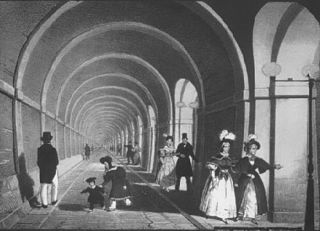
The Thames Tunnel is a tunnel beneath the River Thames in London, connecting Rotherhithe and Wapping. It measures 35 ft (11 m) wide by 20 ft (6.1 m) high and is 1,300 ft (400 m) long, running at a depth of 75 ft (23 m) below the river surface measured at high tide. It is the first tunnel known to have been constructed successfully underneath a navigable river. It was built between 1825 and 1843 by Marc Brunel, and his son, Isambard, using the tunnelling shield newly invented by the elder Brunel and Thomas Cochrane.

Maidenhead Railway Bridge, also known as Maidenhead Viaduct and The Sounding Arch, carries the Great Western Main Line (GWML) over the River Thames between Maidenhead, Berkshire and Taplow, Buckinghamshire, England. It is a single structure of two tall wide red brick arches buttressed by two over-land smaller arches. It crosses the river on the Maidenhead-Bray Reach which is between Boulter's Lock and Bray Lock and is near-centrally rooted in the downstream end of a very small island.
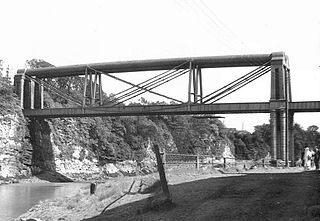
Chepstow Railway Bridge was built to the instructions of Isambard Kingdom Brunel in 1852. The "Great Tubular Bridge" over the River Wye at Chepstow, which at that point forms the boundary between Wales and England, is considered one of Brunel's major achievements, despite its appearance. It was economical in its use of materials, and would prove to be the design prototype for Brunel's Royal Albert Bridge at Saltash. Although the superstructure has since been replaced, Brunel's tubular iron supports are still in place. It is a Grade II listed structure.

The Brunel Museum is a small museum situated at the Brunel Engine House, Rotherhithe, London Borough of Southwark. The Engine House was designed by Sir Marc Isambard Brunel as part of the infrastructure of the Thames Tunnel which opened in 1843 and was the first tunnel to be built under a navigable river anywhere in the world. It comprises the Engine House and the Tunnel Shaft, with rooftop garden. Isambard Kingdom Brunel worked with his father on the project from 1823 and was appointed Resident Engineer in January 1827 at the age of 20.

Llansamlet railway station is a minor station in Llansamlet, Swansea, south Wales. The station is located below street level at Frederick Place in Peniel Green, 212 miles 8 chains (341 km) from London Paddington. It is served by local trains operated by Transport for Wales on the South Wales Main Line between Swansea and Cardiff.

Isambard Kingdom Brunel was a British civil engineer and mechanical engineer who is considered "one of the most ingenious and prolific figures in engineering history", "one of the 19th-century engineering giants", and "one of the greatest figures of the Industrial Revolution, [who] changed the face of the English landscape with his groundbreaking designs and ingenious constructions". Brunel built dockyards, the Great Western Railway (GWR), a series of steamships including the first purpose-built transatlantic steamship, and numerous important bridges and tunnels. His designs revolutionised public transport and modern engineering.

The Loughor railway viaduct carries the West Wales Line across the River Loughor. It is adjacent, and runs parallel to, the Loughor road bridge. The 1880 viaduct was granted Grade II listed building status. Before it was demolished in early 2013, the viaduct was the last remaining timber viaduct designed by Isambard Kingdom Brunel.
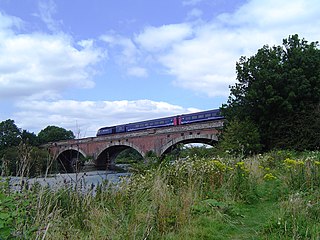
Moulsford Railway Bridge, also known locally as "Four Arches" bridge, is a pair of parallel bridges located a little to the north of Moulsford and South Stoke in Oxfordshire, UK. It carries the Great Western Main Line from Paddington, London to Wales and the West across the River Thames. The bridge lies between the stations at Goring & Streatley and Cholsey, and crosses the Thames at an oblique angle on the reach between Cleeve Lock and Benson Lock.

The Avon Bridge is a railway bridge over the River Avon in Brislington, Bristol, England. It was built in 1839 by Isambard Kingdom Brunel and has been designated by Historic England as a Grade I listed building. The contract was originally awarded to William Ranger, who fell behind with the build and had his construction plant seized so the Great Western Railway company could finish construction. Ranger started legal proceedings against the company, but they were eventually quashed by Lord Cranworth.
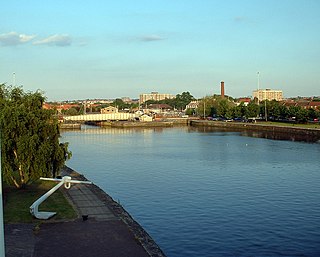
The Cumberland Basin is the main entrance to the docks of the city of Bristol, England. It separates the areas of Hotwells from the tip of Spike Island.

The Wharncliffe Viaduct is a brick-built viaduct that carries the Great Western Main Line railway across the Brent Valley, between Hanwell and Southall, Ealing, UK, at an elevation of 20 metres (66 ft). The viaduct, built in 1836–7, was constructed for the opening of the Great Western Railway (GWR). It is situated between Southall and Hanwell stations, the latter station being only a very short distance away to the east.
Llansamlet is a suburban district and community of Swansea, Wales, falling into the Llansamlet ward. The area is centred on the A48 road and the M4 motorway.
Wickwar railway station served the village of Wickwar in South Gloucestershire, England. The station was on the Bristol and Gloucester Railway, originally a broad gauge line overseen by Isambard Kingdom Brunel, but later taken over by the Midland Railway and converted to standard gauge.

Cockett railway station was a former station on the West Wales Line from Swansea to Gowerton and onwards to Llanelli.
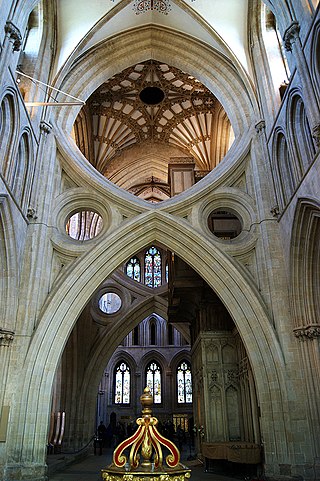
An inverted arch or invert is a civil engineering structure in the form of an inverted arch, inverted in comparison to the usual arch bridge.

A balloon flange girder or (colloquially) balloon topper is a form of vertical I-beam wrought iron plate girder, where the top flange, instead of being a simple flat plate, is extended into a hollow tube. When a girder is subjected to a positive bending moment the top flange acts in compression making a flat plate flange more susceptible to local buckling than the balloon flange is.

A bronze statue of Isambard Kingdom Brunel, also known as Brunel Monument or the Isambard Brunel Monument, by Carlo Marochetti, stands on the Victoria Embankment in London, England, at the west end of Temple Place. The statue rests on a Portland stone pedestal, with flanking screens and benches, by the architect Richard Norman Shaw.

A bronze statue of Robert Stephenson by Carlo Marochetti usually stands on a red granite plinth in the forecourt of Euston railway station in London, England. Erected in 1871, it is one of few surviving elements of the original station after it was redeveloped in the 1960s, and it became a Grade II listed building in 1974. It was temporarily removed in 2020 to allow the station to be remodelled to accommodate the new High Speed 2 (HS2) railway line.

Mile Lane Bridge is a road-over-rail bridge in Coventry, central England. It is possibly the first use of a flying arch over a railway cutting and is a Grade II listed building.